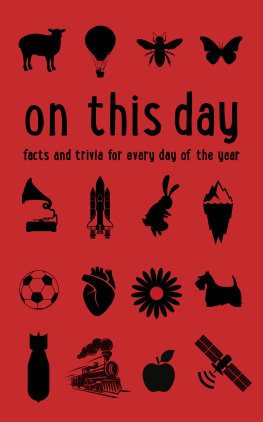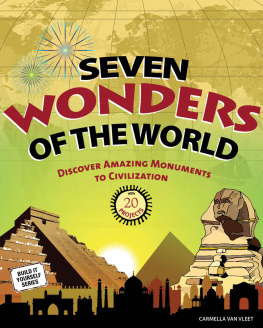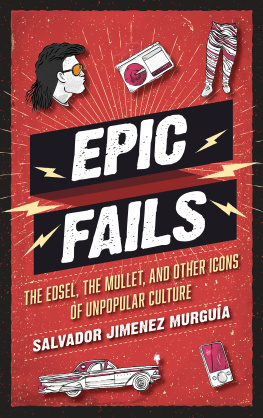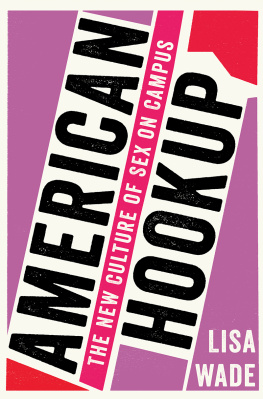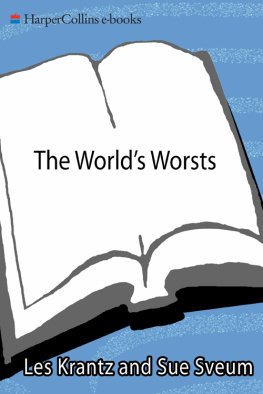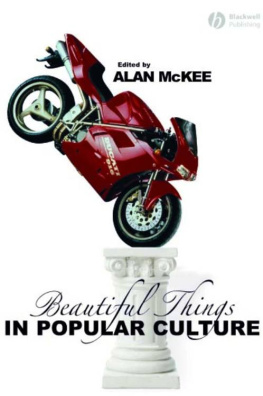# 1
A&P
WAL-MART
BEFORE
WAL-MART
TIMELINE : A&P was founded in 1859; by 1900, there were two hundred stores. By 1930, there were sixteen thousand.
INSPIRED GUESS BY TODAYS YOUNG AND RESTLESS : Two of the three letters needed to spell app.
THE ANCIENT TRUTH : A&P is the name of a grocery store chain, a corporation once as famous as McDonalds or Target and just as dominant in the American consumer market. It was, as the Wall Street Journal once said, Wal-Mart before Wal-Mart. It was founded in the nineteenth century in New York City and was first known for its teas and coffee; eventually, as it expanded into sugar, baking soda, and lots of other products (mostly foodstuffs), it termed itself the Great Atlantic and Pacific Tea Company. A&P stores stood out among other grocery stores in their design features. Some stores actually had faux crystal chandeliers to help you find the green beans (fresh or canned but not yet frozen), and you could buy your forty-five-cent can of one pound Eight OClock coffee from a checkout lady in a seersucker dress sitting in a checkout stand shaped to resemble a pagoda.
In the 1930s, a tenth of Americans bought their groceries at an A&P store.
Hardly ever undersold, A&P offered sharp price reductions based on business of gargantuan volume and pioneered the use of cheap, generic house brands, such as Eight OClock coffee and Jane Parker cakes. A&P was mammoth; its integrated tentacles found their way into not only the stores that sold food, but also the warehouses that stored it and the trucks that carried it. Long before the monster food chains did so in the late twentieth century, A&P drove many independently owned Mom and Pop stores out of business. Mom and Pop were politically powerlessbut the big food distributors were not. Knowing that Mom and Pop would have to pay them higher prices than A&P would, the big distributors went to Congress and called A&P a monopoly. But A&P countered that Congress shouldnt want Americans to pay higher prices for butter and green beans, and with that argument, A&P won the political battle.
But then came something that even A&P could not fight: prosperity.
PostWorld War II America was richer. It demanded bigger, cleaner stores with national brands, like those advertised on TV with the basso ho-ho-ho of the Jolly Green Giant and the wise-guy fish Charlie for StarKist Tuna. For Depression-era America, A&P with its cheap house brands was a boon; for Eisenhowers more affluent America, the cost cutting of A&P was no longer required. A&P tried to respond with larger and more noticeable stores, featuring such architectural notables as cupolas and weather vanes. It was too late. Soon a German corporation (the Tengelmann Group) bought the great but now-struggling Atlantic and Pacific icon. To this day, there are still A&P stores in various parts of the United States, particularly on the East Coast. Compared to the chains grandeur of yesteryear, these stores are few and far between.
For anyone who laments the younger generations unfamiliarity with the phrase A&P, there is an indelible sliver of hope: college students are often assigned a 1961 story by John Updike called A&P. Professors ask their students to read the story because its a riveting tale of what happens when rich snobs invade the puritanical middle-class realm of the local A&P store. Updike traces the clash of classes and culture with exquisite precision and drama.
THAT WAS THEN, THIS IS NOW : For Americans during the first half of the twentieth century, normal shopping tended to involve going to several different stores for various items; there was no such thing as a one-stop shop. Coffee was purchased at the grocery store, but you had to go to the hardware store for light bulbs. And for them, it was normal to ask the clerk to retrieve what they requested, which was often time-consuming. For todays generation, normal is a superstore, part of a much, much larger chain, where a huge variety of products is for sale and where they, not a clerk, select them. For years now, self-service has been as normal as a pair of black socks, and with the Internet, its even possible to cut out the human checkout clerk. But we should remember the A&P in its heyday as one of the great precursors to todays big boxes. Though small by comparison with todays Walmarts, they were among the very biggest boxes around.
HYPOTHETICAL USAGE IN A SENTENCE BY THE OLD AND SETTLED : Do you want me to stop by the A&P to see if they still have kidney beans, six cans for a dollar? Uncle Arthur speaking to Aunt Bea, around April 29, 1946
# 2
ABBOTT AND COSTELLO
WHOS
ON
FIRST?
TIMELINE : Abbott and Costello first worked together in the mid-1930s in New York City. They got on the radio in 1938, which was also the premier date of their most famous skit Whos on First? Their popularity continued through the 40s and 50s.
INSPIRED GUESS BY TODAYS YOUNG AND RESTLESS : Abbott must have been that guy Elvis Costellos first musical partner.
THE ANCIENT TRUTH : Bud Abbott and Lou Costello were the number-one comedy duo in the United States in the 1940s. Into the early 1950s, they were in both radio and films top ten. They were enormously popular, perennially famous, and extremely profitableonly rivaled later in that period by Dean Martin and Jerry Lewis. They started off as New Jersey vaudevilliansperformers on the live variety show stage that marked American life during the Gilded Ageand Costello added to his own rsum, for a while, the title of amateur boxer. Vaudeville was eventually displaced by movies and radio, but it was also the gift that kept on giving, as nearly all the great performers in the new media of radio and film came out of vaudeville, where they found their talent, honed their acts, and sharpened their timing. This was especially true for comedians. Abbott and Costello were poster kids for this genre of vaudevillians who made it big in radio and film.
They were best known for a single radio routine called Whos on First, a spoof that started with the premise that baseball players were developing weird nicknames (such as Dizzy and Daffy Dean of the St. Louis Cardinals). Thus why not have a player named Who on first base, a What on second, and an I Dont Know on third? The mayhem and confusion of such a premise produced a frenzied hilarity, and Abbott and Costello could do the banter speedier than a one-hundred-mile-per-hour fastball.
The angular Abbott was always the straight man, and chubby Costello played the bumbling dunce with the near-soprano voice. The more earnest Abbott put up with Costello, not because he thought a little humor made life whole, but because the laughs made the doughpiles of it. Although they made nearly forty films together and had an addictively popular radio show, bad health, alcoholism, family tragedy (the accidental drowning of Lous baby son), and even a near split ravaged their partnershipfor a whole year, the two only spoke to each other when performing. They did a little early television, but Lou died young and Bud was never good as a solo act. They probably would have fared poorly on television. The media guru Marshall McLuhan always said that TV was a cool medium; intense people didnt go over well on it because they were too hot for viewers living rooms. This might well have been true for Abbott and Costello: too hopped-up for the tube.
Todays generation knows nothing of Abbott and Costello, but they may have picked up a reference or two. The 90s television show Buffy the Vampire Slayer once mentioned the boys, and Montclair State University in New Jersey has a residential wing named after them. Todays young might also have seen a sequel to Whos on First performed by Jimmy Fallon, Billy Crystal, and Jerry Seinfeldavailable on YouTube since 2012. The revival of a classic is always welcome news to those who hope for its ongoing endurance. In early 2014, the skit had enjoyed nearly one million hits.
Next page


